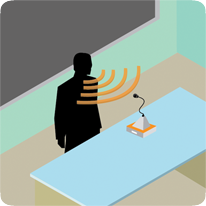Planning an Induction Loop System
There are a number of factors which need to be considered before undertaking an installation of an induction loop. The key points below need to be considered before proceeding too far with a scheme which ends up fails to perform correctly.
Before all else it needs to be considered if the location and manner of use for the proposed AFILS system is in fact, practical. There are many induction loops being specified for buildings and construction projects to satisfy DDA requirements, where there would be little to no practical benefit for an actual user. Ensuring the proposed system is in fact a benefit is important to ensure a complex, costly and time consuming installation does not prove to be an expensive waste of time.
- What actual speech content or source needs to be enhanced?
A church minister, court judge, performer on stage, speaker in a lecture are all great examples of suitable content for an induction loop system)
- For what length of time would a user listen to the content?
(Someone sat for some time listening to someone speaking will benefit far more than someone stopping briefly at a point and switching their hearing aid)
- How can a perimeter loop cable be installed within the room or space?
(A simple loop requires a cable to be installed around the room in a safe and discrete manner)
- Is confidentiality of any spoken word in the system a requirement?
(Standard loops will overspill outside of the room being covered and could be monitored by unauthorised individuals, therefore a low overspill loop is a requirement)
- How could a multiple loop array be laid across the floor or ceiling of the room for low overspill?
(Low overspill loops require a complex arrangement to contain overspill and this needs to be arranged in a practical manner.)
- Is there a large metal content in close proximity of the room (see list)
(Metalwork can seriously effect the performance of loop systems by absorbing the magnetic field strength – result is a poorly performing loop of no benefit to anyone)
- Is there a presence of sodium or metal halide lighting in the immediate area of the proposed loop?
(Some light fittings (particularly with ballast) create interference which is audible to hearing aid users and creates noise which impairs the audio quality on the loop.)
- Would infra-red be an alternative solution?
(Infra red systems offer a wireless transmission means which eliminates many of the issues of metal loss and low overspill problems.)
- Is the venue capable of managing the issue, retrieval and maintenance of IR receivers and their batteries?
(Infra red systems need to be used with dedicated receivers which need managing, conventional AFILS loops need little attention apart from periodic checking. )
The key point to remember is that the hearing aid user hears what goes through the microphone – both the speaker’s voice and any background noise. To benefit from induction loops the speaker’s voice must ALWAYS be close to the microphone to ensure that it predominates over background noise.
Sometimes a public address or sound system may already be installed which may be used as the sound source, or perhaps a more sophisticated arrangement may be planned with inputs from various sources.
In the absence of an existing sound system it will be necessary to provide microphones and inputs to the loop amplifier for any other signals. When microphones are to be used it is vital that they are positioned to pick up sound, which is free from reverberation and other noises. If the microphones receive a poor signal then the signal transmitted to the listener will be poor no matter how good the design of the loop and other equipment. It is also necessary to ensure that the microphones are matched electrically to the amplifier so that it is ‘driven’ adequately when the loop is in operation.

When positioning microphones in rooms, the microphones should be as close to the person speaking as is practicable, for example in a classroom if the microphone is placed in the ceiling in the room centre, the loop microphone will be further away from the speaker than the microphone in the hearing aid of someone sitting on the front row of the class!
All loop installations in the UK should conform to the Code of practice BS7594, this gives advice on the minimum areas to be covered, positioning of microphones and commissioning the system. Systems should be set up and tested to the requirements of EN 60118-4 which lays down requirements for magnetic field strength.









